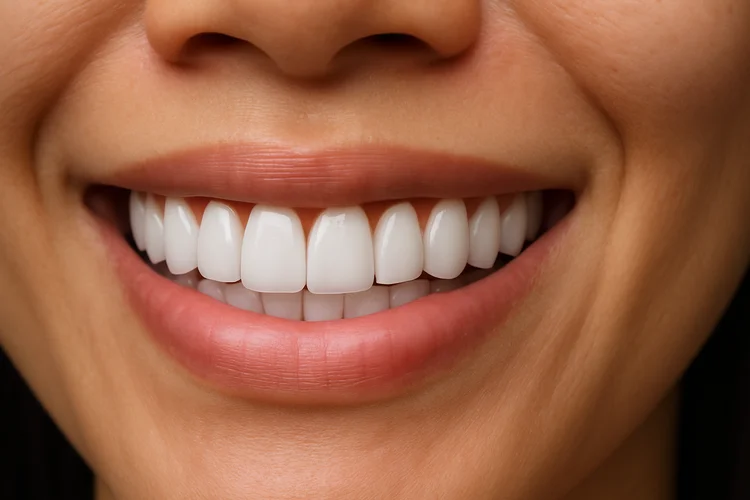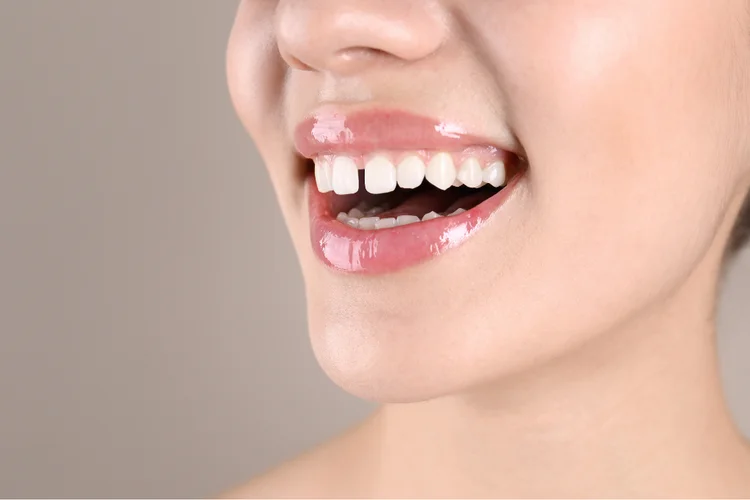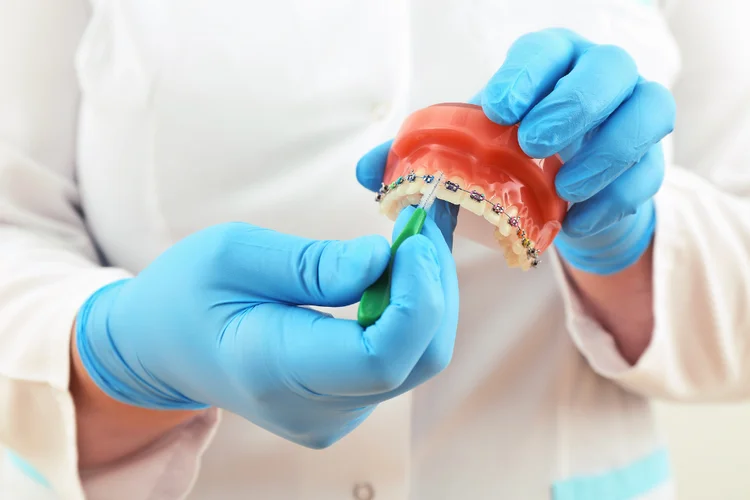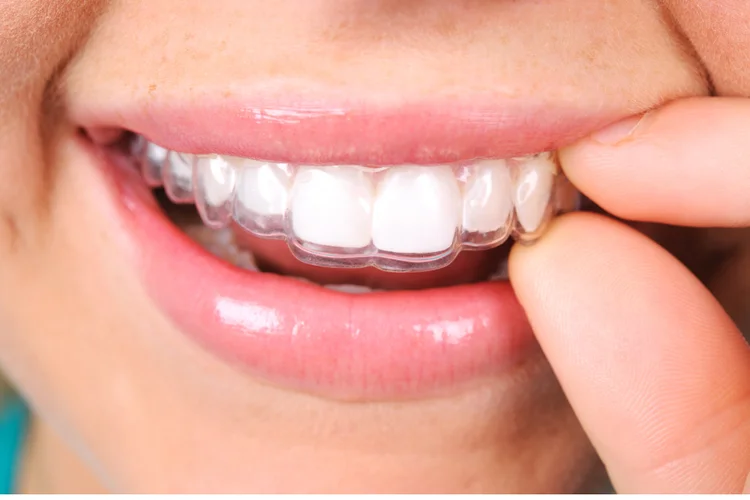

Veneers and braces are both dental treatments that improve the appearance of your
teeth, but they differ in their primary purpose, treatment time, daily
impact, oral health considerations, and cost.
If you are unsure which option is right for you, you are not alone. Many patients
face this decision when considering their dental condition, cosmetic goals, and
long-term expectations.
In this guide, we outline the key differences between veneers and braces to help you
make a more informed and confident choice for your smile.
| Aspect | Veneers | Braces |
|---|---|---|
| 1. Purpose |
|
|
| 2. Treatment Time |
|
|
| 3. Oral Health |
|
|
| 4. Impact on Daily Life |
|
|
| 5. Longevity and Maintenance |
|
|
| 6. Cost |
|
|
What Are Veneers and Braces?
Veneers are thin shells made of porcelain or composite resin that are bonded to the
front surface of the teeth. They are custom-made to fit each tooth and are securely
attached using dental adhesive to create a natural-looking outer layer.
Braces are orthodontic appliances that apply continuous, controlled pressure to
gradually move teeth into proper alignment. They are available in different forms,
including metal brackets, ceramic brackets, and clear aligners such as Invisalign® or Zenyum, and
require periodic adjustments to guide tooth movement over time.
1. What Do Veneers and Braces Treat?
Veneers improve the cosmetic appearance of teeth, while braces
correct alignment and functional bite issues.
Veneers are used to mask aesthetic imperfections such as stains, chips,
uneven tooth shapes, and minor gaps. They can dramatically enhance the
colour, shape, and size of teeth but do not move teeth or address underlying
alignment or bite concerns.
Braces treat structural dental problems by applying controlled pressure to
reposition teeth over time. While they also enhance appearance by
straightening the natural teeth, braces are often necessary to address
fundamental issues that affect oral function, such as misalignment, crowding,
or bite irregularities.

2. Treatment Time: How Long Does Each Take?
Veneers take weeks; braces require months to years.
Veneers usually require one to three dental appointments over a few weeks, as the
process involves reshaping and covering the front surface of the teeth rather than
moving them over time.
Braces generally take 12 to 24 months or more to move the teeth into proper
alignment, depending on the complexity of the case. Clear aligners may require
slightly less time for mild to moderate cases due to more targeted tooth movement
and fewer in-clinic adjustments.
After the braces are removed, a retainer
is usually prescribed to maintain the new positions. Retainers are typically worn
full-time at first, then reduced to night-time wear for several months to a few
years, depending on individual needs.
3. Oral Health Impact: Are There Any Risks?
Veneers involve enamel removal, while braces can increase plaque
buildup if oral hygiene is inadequate.
Veneers require the removal of a thin layer of enamel, which is irreversible
and may increase tooth sensitivity. They can also be damaged by biting hard
objects, and poor oral habits may affect their durability over time.
Braces do not alter the structure of the teeth but can create hard-to-clean
areas where food and plaque accumulate. Without diligent oral hygiene, this
can increase the risk of tooth decay and gum disease during treatment.

4. Daily Life: How Do They Affect Your Routine?
Veneers generally do not affect speech or eating, while braces may require
temporary lifestyle adjustments during treatment.
Veneers do not cause noticeable changes to daily speech or eating. However, habits
such as nail-biting, smoking, or frequent consumption of staining foods and drinks
can affect their appearance and durability over time.
Braces may lead to short-term changes in speech and eating, particularly during the
initial adjustment period. Hard, sticky, or chewy foods should be avoided to prevent
damage to brackets or wires. Clear aligners may offer more flexibility but still
require consistent wear throughout the day to remain effective.
5. Longevity and Maintenance: Which Lasts Longer?
Veneers typically require replacement over time, while braces create
long-term alignment changes.
Veneers usually last 10 to 15 years, depending on the material used and
individual oral habits. They may need to be replaced due to gradual wear,
surface discolouration, or accidental damage.
Braces lead to lasting changes in tooth position by physically shifting the
teeth into better alignment, provided a retainer is worn consistently after
treatment to prevent them from gradually shifting back over time.

6. Cost Comparison: Are Veneers or Braces More Affordable?
Veneers may cost more per tooth; braces have a higher total treatment
fee.
In Singapore, veneers generally range from $900 to $2,500 per tooth, depending on
the material used. Braces typically range from $3,000 to $10,000 in total, depending
on the type and the complexity of the case.
While veneers offer fast cosmetic results, they are not a substitute for the
functional correction braces provide, and future replacement should be factored into
long-term cost considerations.
At True Dental Studio, we offer composite
and porcelain veneers, as well as Invisalign. Our
prices are as follows:
| Treatment | Price* |
|---|---|
| Consultation | $27.25 to $65.40 |
| Composite Veneer | From $327 |
| Porcelain Veneer | From $1,090 |
| Invisalign / Invisible Braces | $3,924 to $9,810^ |
*Prices are NETT and inclusive of GST.
^Medium-complexity cases generally range from $5995* to $7085*. Prices
vary based on complexity and may exceed the stated amount. All patients are
subjected to an initial assessment.
Veneers vs Braces: Which Is Right for You?
The right choice for you depends on your treatment goals and dental
condition.
Veneers and braces serve different primary purposes. If your main concern is the
cosmetic appearance of minor flaws such as chips, stains, or small gaps, veneers may
be a suitable option. If you need to correct tooth alignment, improve bite function,
or address issues like spacing or crowding, braces are likely to be more
appropriate.
At True Dental Studio, we offer personalised assessments to help you make informed
decisions. Whether you are considering veneers, clear aligners, or a combination of
treatments, our team will guide you based on your individual goals and oral health.
Read more on:
- Teeth Veneer Process
- Composite vs Porcelain Veneers
- Veneer Cost in Singapore
- Veneers or Crowns
- Invisalign vs Braces
- How Does Invisalign Work?
Book an Appointment With Our Friendly Dentists Today!
Book Dental Appointment
Book NowEnquire More Through Email
Email Us NowEnquire More Through WhatsApp
WhatsApp Us NowWhy Choose True Dental Studio?
Friendly Dentist and Team
Our team treats each and every patient to the best of our ability. This is the reason why entire families have continued their dental care with True Dental Studio for many years, from all over Singapore.
Minimal Discomfort
At True Dental, it is our commitment to ensure our patients are kept as comfortable as possible. We aim to minimize discomfort, if any, for our patients.
Affordable Treatments
We believe in pricing quality treatments at a competitive rate. We are transparent and upfront with our treatment costs.
Our Smile Scorecard
Frequently Asked Questions
Braces are generally recommended before veneers if alignment or bite correction is needed. Braces move teeth into the correct position, allowing veneers to be placed more conservatively and precisely afterwards if desired for cosmetic refinement. It is advisable to consult a dentist or orthodontist to determine the appropriate sequence based on your clinical needs and treatment goals.
Veneers may be an alternative to braces if the concern is purely cosmetic and involves minor spacing, slight misalignment, or imperfections in shape or colour. However, veneers do not correct bite problems or significant alignment issues. Consulting a dentist can help determine if veneers alone are appropriate or if orthodontic treatment is necessary first.
Braces should typically come before veneers when tooth alignment, bite correction, or spacing needs to be addressed. Straightening the teeth first allows for more precise veneer placement and can improve their long-term success. Placing veneers beforehand may limit tooth movement or lead to suboptimal results. It is advisable to consult a dentist or orthodontist for a proper assessment and treatment plan.
People may choose veneers over braces when they want faster cosmetic results or have minor imperfections such as chips, stains, or small gaps. Veneers can improve shape and colour without moving the teeth. However, they are not suitable for correcting alignment or bite issues. Consulting a dentist can help assess whether veneers meet your functional and aesthetic needs.
Braces are better suited for correcting alignment and bite issues, while veneers are ideal for masking cosmetic flaws like chips or discolouration. The right choice depends on whether your concerns are functional, aesthetic, or both. Consulting a dentist can help determine which treatment better meets your dental condition and long-term goals.
Veneers require the removal of enamel, which is irreversible and may increase sensitivity. They can chip or wear down over time and typically need replacement every 10 to 15 years. Additionally, veneers do not correct underlying alignment or bite issues. It is advisable to consult a dentist to assess whether veneers are suitable for your oral health.
Veneers may cause short-term sensitivity from enamel removal, while braces can lead to temporary discomfort from tooth movement during adjustments. The type and intensity of discomfort differ and vary by individual. Consulting a dentist can help you understand what to expect from each treatment and determine which option aligns better with your tolerance and treatment goals.
Veneers are generally recommended for adults once the teeth and jaws have fully developed, usually by the late teens or early twenties. They are often used to address cosmetic concerns such as chips, discolouration, or uneven teeth. It is advisable to consult a dentist to determine the appropriate timing based on your dental development and treatment goals.
No, you cannot fully return to your natural teeth after veneers, as the procedure involves permanent enamel removal. Once applied, veneers must be maintained and eventually replaced. It is advisable to consult a dentist to fully understand the long-term commitment before proceeding with treatment.
Veneers may not be suitable for individuals with untreated gum disease, significant misalignment, teeth grinding habits, or insufficient enamel. They are also not recommended when functional correction is needed, in which case braces or clear aligners may be more appropriate. Consulting a dentist can help determine whether veneers are suitable based on your oral health and treatment needs.
Switching from braces to veneers mid-treatment is generally not recommended, as veneers do not replace the functional correction that braces provide. However, veneers may be placed after completing orthodontic treatment to enhance tooth shape, size, or colour. Consulting a dentist can help determine whether veneers are appropriate based on your treatment progress and cosmetic goals.
Teeth can still shift under veneers if there are underlying alignment issues or if retainers are not worn after orthodontic treatment. Veneers are bonded to the front surface of teeth and do not prevent natural tooth movement. Consulting a dentist can help determine if orthodontic treatment or retention is needed before or after veneers.
Yes, most veneers require the removal of a thin layer of enamel to allow proper fit and bonding. This process is generally minimal but irreversible. The amount of enamel removed depends on the veneer type and individual tooth structure. It is advisable to consult a dentist to understand what this involves in your specific case.
Teeth can develop issues under veneers if oral hygiene is poor or if the veneers are improperly bonded, allowing bacteria to accumulate. Regular brushing, flossing, and dental check-ups are essential to maintain oral health. It is advisable to consult a dentist to assess the condition of your teeth before placing veneers.
If you are unhappy with your veneers, they can usually be adjusted, remade, or replaced. However, because enamel is permanently removed during preparation, the underlying teeth will always require some form of restoration. Consulting a dentist can help assess your concerns and recommend an appropriate solution based on your expectations and dental condition.
